child seat HONDA CIVIC COUPE 1999 Owners Manual
[x] Cancel search | Manufacturer: HONDA, Model Year: 1999, Model line: CIVIC COUPE, Model: HONDA CIVIC COUPE 1999Pages: 269, PDF Size: 2.42 MB
Page 6 of 269
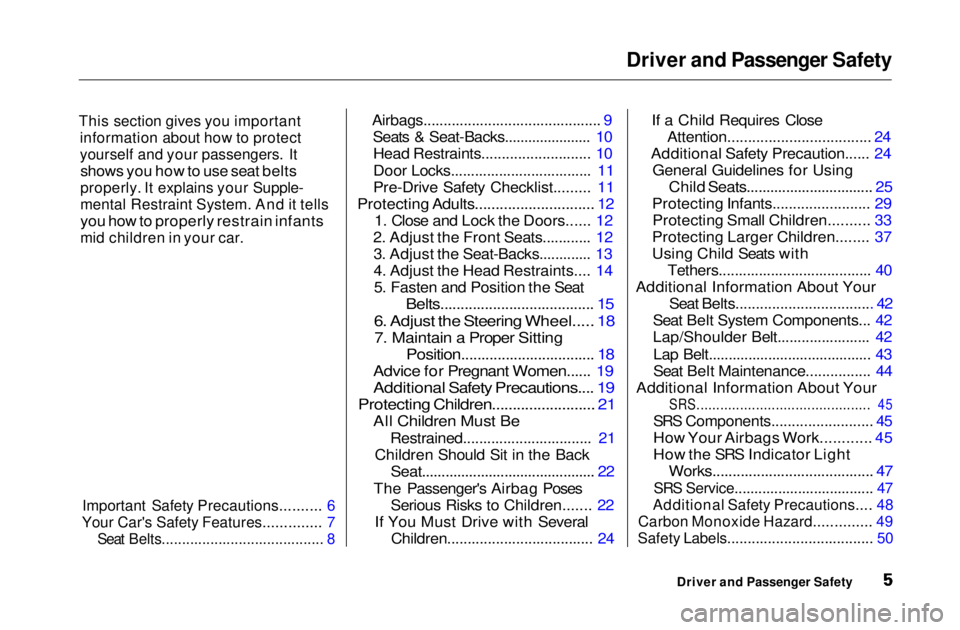
Driver and Passenger Safety
This section gives you important
information about how to protect
yourself and your passengers. It
shows you how to use seat belts
properly. It explains your Supple-
mental Restraint System. And it tells
you how to properly restrain infants
mid children in your car.
Important Safety Precautions.......... 6
Your Car's Safety Features.............. 7
Seat Belts........................................ 8
Airbags............................................ 9
Seats & Seat-Backs...................... 10Head Restraints........................... 10
Door Locks................................... 11
Pre-Drive Safety Checklist......... 11
Protecting Adults............................. 12
1. Close and Lock the Doors...... 12
2. Adjust the Front Seats............ 12 3. Adjust the Seat-Backs............. 13
4. Adjust the Head Restraints.... 145. Fasten and Position the Seat
Belts...................................... 15
6. Adjust the Steering Wheel..... 18
7. Maintain a Proper Sitting
Position................................. 18
Advice for Pregnant Women...... 19
Additional Safety Precautions.... 19
Protecting Children......................... 21
All Children Must Be
Restrained................................ 21
Children Should Sit in the Back
Seat............................................ 22
The Passenger's Airbag Poses Serious Risks to Children....... 22
If You Must Drive with Several Children.................................... 24 If a Child Requires Close
Attention................................... 24
Additional Safety Precaution...... 24 General Guidelines for Using
Child Seats................................ 25
Protecting Infants........................ 29 Protecting Small Children.......... 33
Protecting Larger Children........ 37
Using Child Seats with Tethers...................................... 40
Additional Information About Your
Seat Belts.................................. 42
Seat Belt System Components... 42
Lap/Shoulder Belt....................... 42
Lap Belt......................................... 43
Seat Belt Maintenance................ 44
Additional Information About Your
SRS............................................ 45
SRS Components......................... 45
How Your Airbags Work............ 45
How the SRS Indicator Light
Works........................................ 47
SRS Service................................... 47
Additional Safety Precautions.... 48
Carbon Monoxide Hazard.............. 49
Safety Labels.................................... 50
Driver and Passenger SafetyMain Menu s t
Page 7 of 269
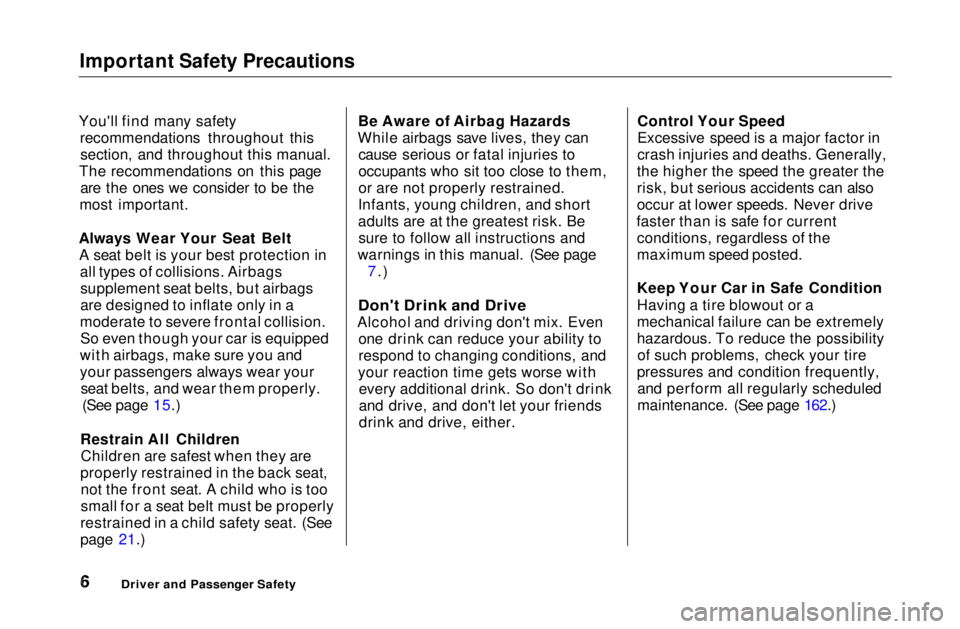
Important Safety Precautions
You'll find many safety recommendations throughout thissection, and throughout this manual.
The recommendations on this page are the ones we consider to be the
most important.
Always Wear Your Seat Belt
A seat bel
t is your best protection in
all types of collisions. Airbags supplement seat belts, but airbags
are designed to inflate only in a
moderate to severe frontal collision. So even though your car is equipped
with airbags, make sure you and
your passengers always wear your seat belts, and wear them properly. (See page 15.)
Restrain All Children Children are safest when they are
properly restrained in the back seat, not the front seat. A child who is too
small for a seat belt must be properly
restrained in a child safety seat. (See
page 21.) Be Aware of Airbag Hazards
While airbags save lives, they can cause serious or fatal injuries to
occupants who sit too close to them,
or are not properly restrained.
Infants, young children, and short
adults are at the greatest risk. Be sure to follow all instructions and
warnings in this manual. (See page 7.)
Don't Drink and Drive
Alcohol and driving don't mix. Even one drink can reduce your ability to
respond to changing conditions, and
your reaction time gets worse with every additional drink. So don't drink
and drive, and don't let your friends
drink and drive, either. Control Your Speed
Excessive speed is a major factor in
crash injuries and deaths. Generally,
the higher the speed the greater the
risk, but serious accidents can also
occur at lower speeds. Never drive
faster than is safe for current conditions, regardless of the
maximum speed posted.
Keep Your Car in Safe Condition
Having a tire blowout or a
mechanical failure can be extremely
hazardous. To reduce the possibilityof such problems, check your tire
pressures and condition frequently, and perform all regularly scheduled
maintenance. (See page 162.)
Driver and Passenger SafetyMain Menu Table of Contents s t
Page 9 of 269
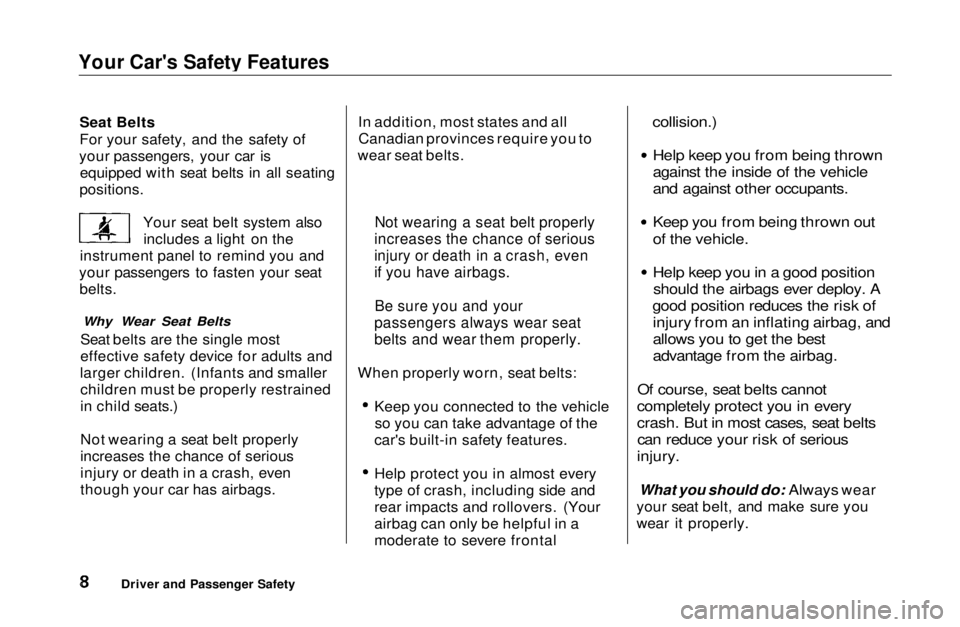
Your Car's Safety Features
Seat Belts
For your safety, and the safety of
your passengers, your car is equipped with seat belts in all seating
positions.
Your seat belt system alsoincludes a light on the
instrument panel to remind you and
your passengers to fasten your seat belts.
Why Wear Seat Belts
Seat belts are the single most
effective safety device for adults and
larger children. (Infants and smaller children must be properly restrained
in child seats.)
Not wearing a seat belt properly
increases the chance of serious
injury or death in a crash, even
though your car has airbags. In addition, most states and all
Canadian provinces require you to
wear seat belts.
When properly worn, seat belts:
Keep you connected to the vehicleso you can take advantage of the
car's built-in safety features. Help protect you in almost every
type of crash, including side and
rear impacts and rollovers. (Your
airbag can only be helpful in a
moderate to severe frontal
collision.)
Help keep you from being thrown
against the inside of the vehicle
and against other occupants.
Keep you from being thrown out
of the vehicle. Help keep you in a good position
should the airbags ever deploy. A
good position reduces the risk of injury from an inflating airbag, and
allows you to get the best
advantage from the airbag.
Of course, seat belts cannot
completely protect you in every
crash. But in most cases, seat belts can reduce your risk of serious
injury.
What you should do: Always wear
your sea t
belt, and make sure you
wear it properly.
Driver and Passenger Safety
Not wearing a seat belt properly
increases the chance of serious
injury or death in a crash, even
if you have airbags.
Be sure you and your
passengers always wear seat
belts and wear them properly.Main Menu Table of Contents s t
Page 10 of 269
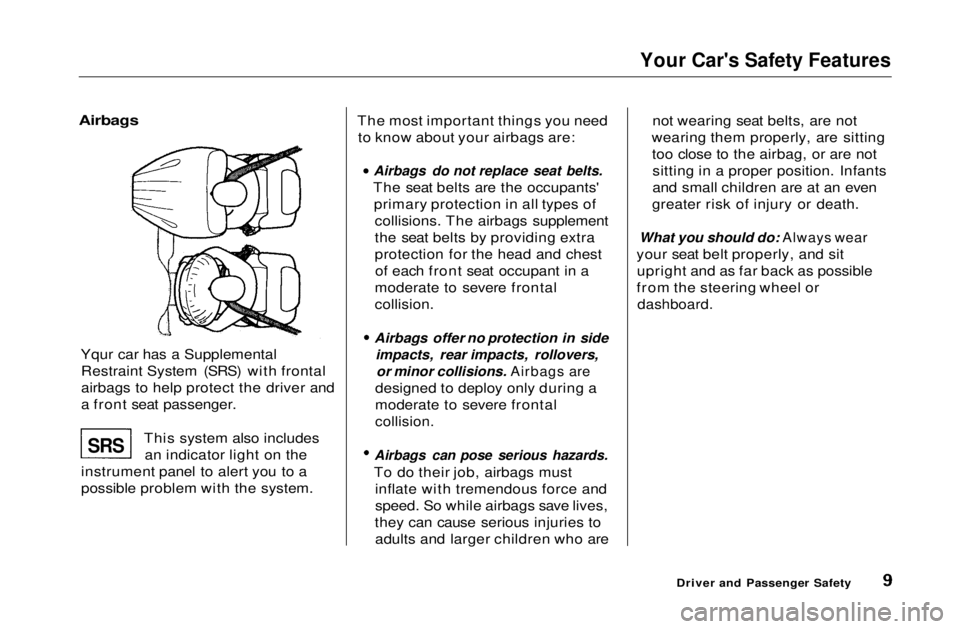
Your Car's Safety Features
Airbags
Yqur car has a SupplementalRestraint System (SRS) with frontal
airbags to help protect the driver and
a front seat passenger.
This system also includesan indicator light on the
instrument panel to alert you to a
possible problem with the system. The most important things you need
to know about your airbags are:
Airbags do not replace seat belts.
The seat belts are the occupants' primary protection in all types ofcollisions. The airbags supplement
the seat belts by providing extra
protection for the head and chestof each front seat occupant in a
moderate to severe frontal
collision.
Airbags offer no protection in side
impacts, rear impacts, rollovers,
or minor collisions. Airbags are
designed to deploy only during a
moderate to severe frontal
collision.
Airbags can pose serious hazards.
To do their job, airbags must inflate with tremendous force and
speed. So while airbags save lives,
they can cause serious injuries to adults and larger children who are not wearing seat belts, are not
wearing them properly, are sitting too close to the airbag, or are notsitting in a proper position. Infants
and small children are at an even
greater risk of injury or death.
What you should do: Always wear
your seat belt properly, and sit upright and as far back as possible
from the steering wheel or
dashboard.
Driver and Passenger Safety
SRSMain Menu Table of Contents s t
Page 12 of 269
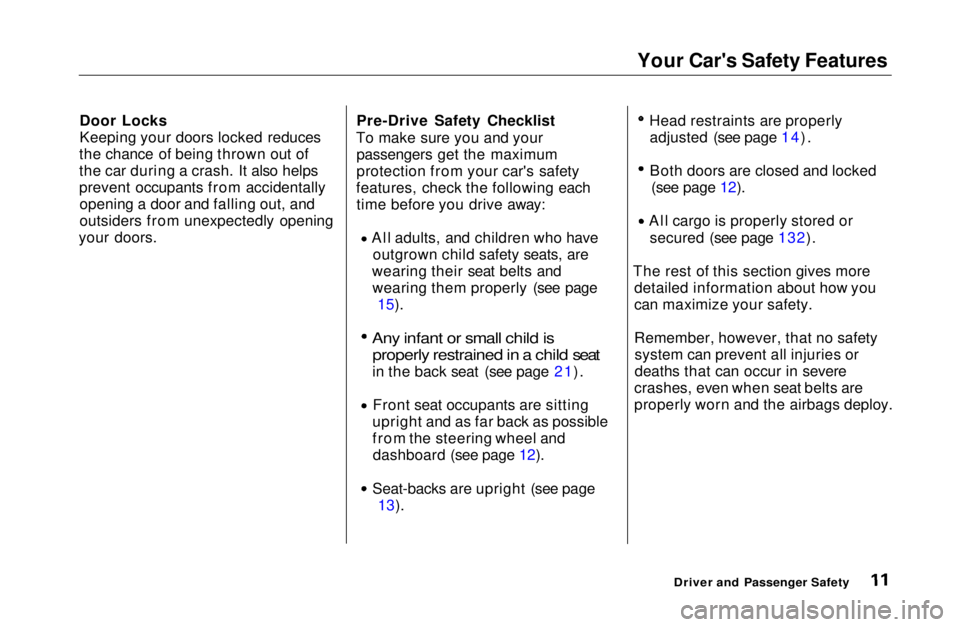
Your Car's Safety Features
Door Locks
Keeping your doors locked reduces
the chance of being thrown out of
the car during a crash. It also helps
prevent occupants from accidentally opening a door and falling out, and
outsiders from unexpectedly opening
your doors. Pre-Drive Safety Checklist
To make sure you and your passengers get the maximum
protection from your car's safety
features, check the following each time before you drive away: All adults, and children who have
outgrown child safety seats, are
wearing their seat belts and wearing them properly (see page 15).
Any infant or small child is
properly restrained in a child seat
in the back seat (see page 21). Front seat occupants are sitting
upright and as far back as possible
from the steering wheel and dashboard (see page 12). Seat-backs are upright (see page
13). Head restraints are properly
adjusted (see page 14). Both doors are closed and locked
(see page 12). All cargo is properly stored or
secured (see page 132).
The rest of this section gives more detailed information about how you
can maximize your safety.
Remember, however, that no safetysystem can prevent all injuries or
deaths that can occur in severe
crashes, even when seat belts are
properly worn and the airbags deploy.
Driver and Passenger SafetyMain Menu Table of Contents s t
Page 13 of 269
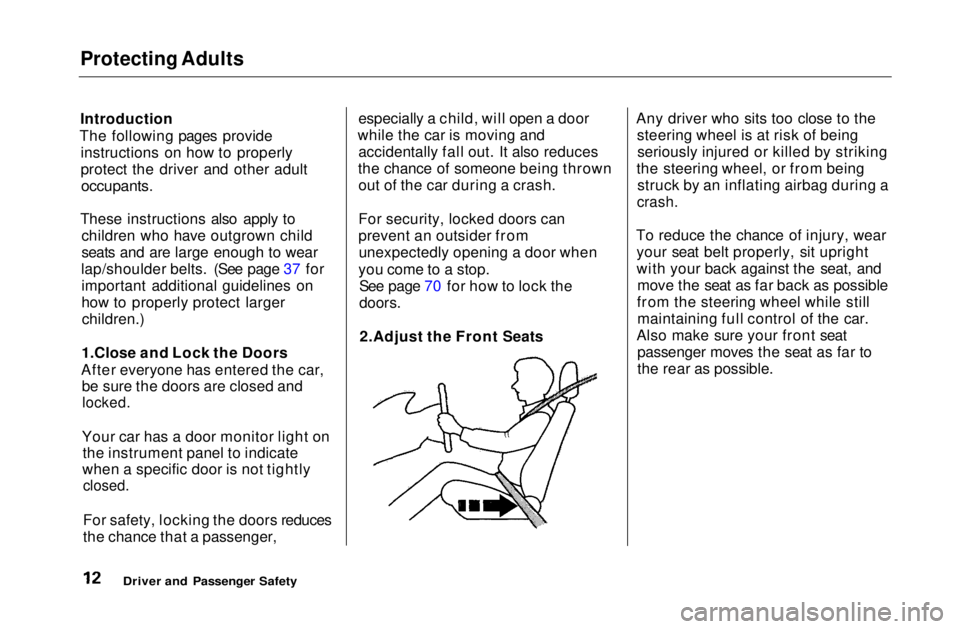
Protecting Adults
Introduction
The following pages provide instructions on how to properly
protect the driver and other adult
occupants.
These instructions also apply to children who have outgrown child
seats and are large enough to wear
lap/shoulder belts. (See page 37 for important additional guidelines on
how to properly protect largerchildren.)
1.Close and Lock the Doors
After everyone has entered the car, be sure the doors are closed and
locked.
Your car has a door monitor light on the instrument panel to indicate
when a specific door is not tightly
closed.
For safety, locking the doors reduces
the chance that a passenger, especially a child, will open a door
while the car is moving and accidentally fall out. It also reduces
the chance of someone being thrown out of the car during a crash.
For security, locked doors can
prevent an outsider fromunexpectedly opening a door when
you come to a stop. See page 70 for how to lock the
doors.
2.Adjust the Front Seats Any driver who sits too close to the
steering wheel is at risk of beingseriously injured or killed by striking
the steering wheel, or from being struck by an inflating airbag during a
crash.
To reduce the chance of injury, wear your seat belt properly, sit upright
with your back against the seat, and move the seat as far back as possible
from the steering wheel while still maintaining full control of the car.
Also make sure your front seat passenger moves the seat as far to
the rear as possible.
Driver and Passenger SafetyMain Menu Table of Contents s t
Page 20 of 269
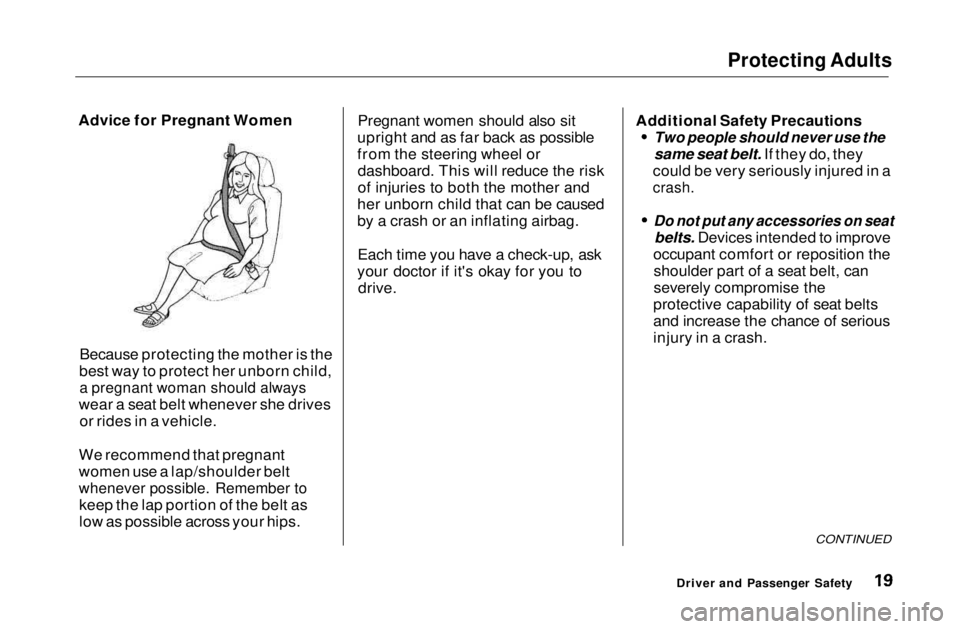
Protecting Adults
Advice for Pregnant Women
Because protecting the mother is the
best way to protect her unborn child,
a pregnant woman should always
wear a seat belt whenever she drives or rides in a vehicle.
We recommend that pregnant
women use a lap/shoulder belt
whenever possible. Remember to
keep the lap portion of the belt as
low as possible across your hips. Pregnant women should also sit
upright and as far back as possible
from the steering wheel or dashboard. This will reduce the risk
of injuries to both the mother and
her unborn child that can be caused
by a crash or an inflating airbag.
Each time you have a check-up, ask
your doctor if it's okay for you to drive. Additional Safety Precautions
Two people should never use the
same seat belt. If they do, they
could be very seriously injured in a
crash.
Do not put any accessories on seat
belts. Devices intended to improve
occupant comfort or reposition the shoulder part of a seat belt, can
severely compromise the
protective capability of seat belts
and increase the chance of serious
injury in a crash.
CONTINUED
Driver and Passenger SafetyMain Menu Table of Contents s t
Page 22 of 269
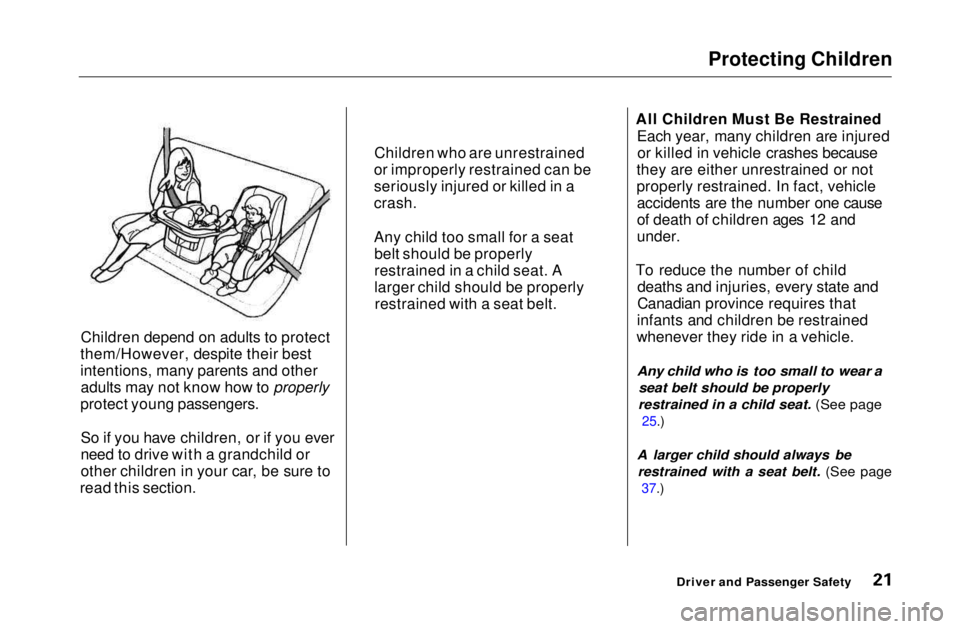
Protecting Children
Children depend on adults to protect
them/However, despite their best
intentions, many parents and other adults may not know how to properly
protect young passengers.
So if you have children, or if you ever
need to drive with a grandchild or
other children in your car, be sure to
read this section. All Children Must Be Restrained
Each year, many children are injuredor killed in vehicle crashes because
they are either unrestrained or not
properly restrained. In fact, vehicle accidents are the number one cause
of death of children ages 12 and
under.
To reduce the number of child deaths and injuries, every state and
Canadian province requires that
infants and children be restrained
whenever they ride in a vehicle.
Any child who is too small to wear a seat belt should be properly
restrained in a child seat. (See page
25.)
A larger child should always be
restrained with a seat belt. (See page
37.)
Driver and Passenger Safety
Children who are unrestrained
or improperly restrained can be
seriously injured or killed in a
crash.
Any child too small for a seat belt should be properly
restrained in a child seat. A
larger child should be properlyrestrained with a seat belt.Main Menu Table of Contents s t
Page 23 of 269
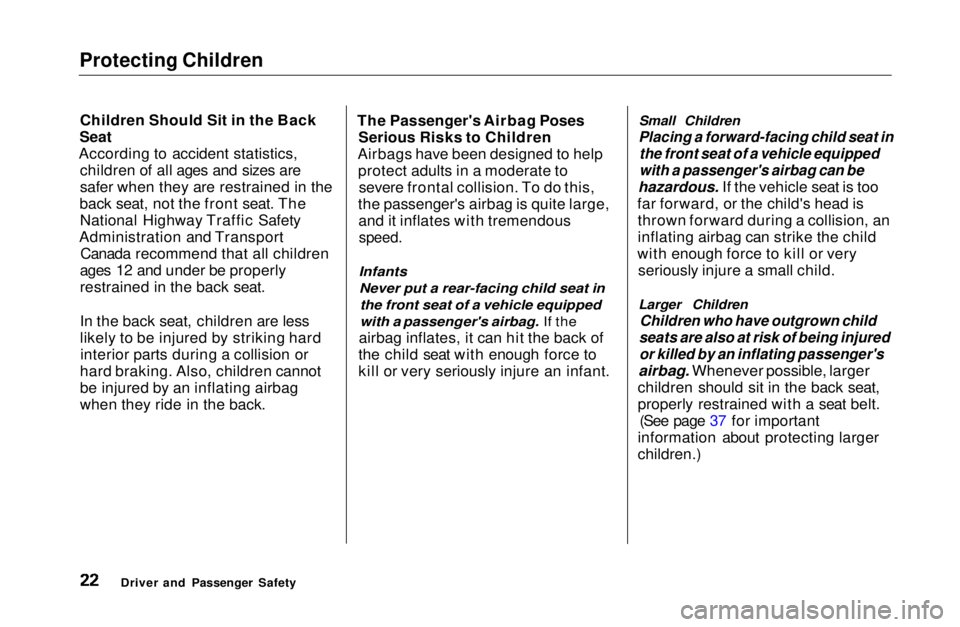
Protecting Children
Children Should Sit in the Back
Seat
According to accident statistics, children of all ages and sizes are
safer when they are restrained in the
back seat, not the front seat. The National Highway Traffic Safety
Administration and Transport Canada recommend that all children
ages 12 and under be properly
restrained in the back seat.
In the back seat, children are less
likely to be injured by striking hard interior parts during a collision or
hard braking. Also, children cannot
be injured by an inflating airbag
when they ride in the back. The Passenger's Airbag Poses
Serious Risks to Children
Airbags have been designed to help protect adults in a moderate to severe frontal collision. To do this,
the passenger's airbag is quite large, and it inflates with tremendous
speed.
InfantsNever put a rear-facing child seat in the front seat of a vehicle equipped
with a passenger's airbag. If the
airbag inflates, it can hit the back of
the child seat with enough force to
kill or very seriously injure an infant. Small Children
Placing a forward-facing child seat in the front seat of a vehicle equipped
with a passenger's airbag can be
hazardous. If the vehicle seat is too
far forward, or the child's head is thrown forward during a collision, an
inflating airbag can strike the child
with enough force to kill or very seriously injure a small child.
Larger Children
Children who have outgrown child
seats are also at risk of being injured or killed by an inflating passenger's
airbag. Whenever possible, larger
children should sit in the back seat,
properly restrained with a seat belt. (See page 37 for important
information about protecting larger
children.)
Driver and Passenger SafetyMain Menu Table of Contents s t
Page 24 of 269
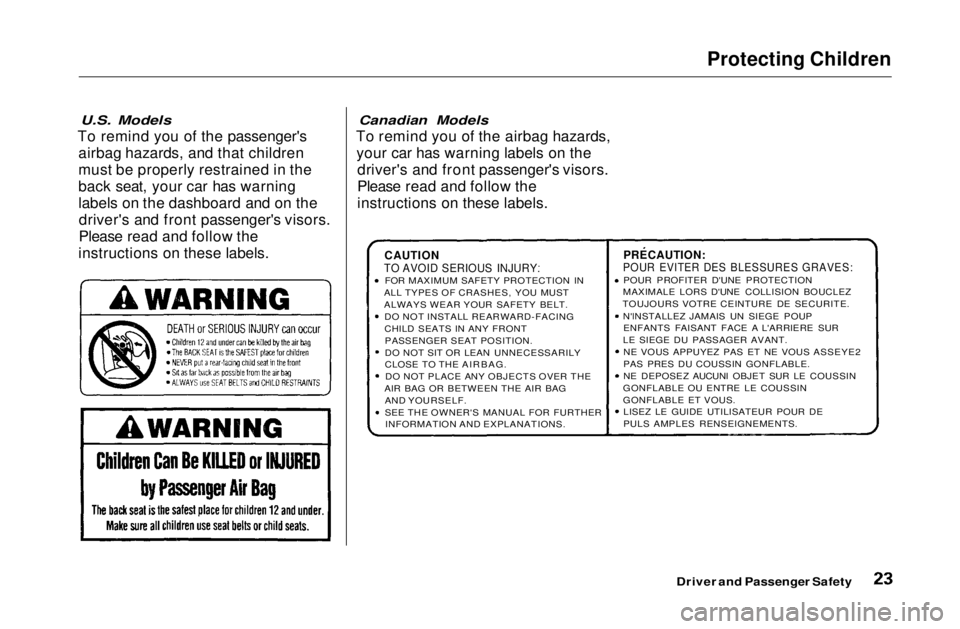
Protecting Children
U.S. Models
To remind you of the passenger's airbag hazards, and that children
must be properly restrained in the
back seat, your car has warning
labels on the dashboard and on thedriver's and front passenger's visors.
Please read and follow the
instructions on these labels.
Canadian Models
To remind you of the airbag hazards, your car has warning labels on the driver's and front passenger's visors.
Please read and follow the
instructions on these labels.
Driver and Passenger Safety
CAUTION
TO AVOID SERIOUS INJURY.
FOR MAXIMUM SAFETY PROTECTION IN
ALL TYPES OF CRASHES, YOU MUST
ALWAYS WEAR YOUR SAFETY BELT. DO NOT INSTALL REARWARD-FACING
CHILD SEATS IN ANY FRONTPASSENGER SEAT POSITION.
DO NOT SIT OR LEAN UNNECESSARILY
CLOSE TO THE AIRBAG.DO NOT PLACE ANY OBJECTS OVER THE
AIR BAG OR BETWEEN THE AIR BAG AND YOURSELF.
SEE THE OWNER'S MANUAL FOR FURTHERINFORMATION AND EXPLANATIONS.
PRECAUTION:
POUR EVITER DES BLESSURES GRAVES:
POUR PROFITER D'UNE PROTECTION
MAXIMALE LORS D'UNE COLLISION BOUCLEZ
TOUJOURS VOTRE CEINTURE DE SECURITE.
N'lNSTALLEZ JAMAIS UN SIEGE POUPENFANTS FAISANT FACE A L'ARRIERE SUR
LE SIEGE DU PASSAGER AVANT. NE VOUS APPUYEZ PAS ET NE VOUS ASSEYE2
PAS PRES DU COUSSIN GONFLABLE.
NE DEPOSEZ AUCUNI OBJET SUR LE COUSSIN
GONFLABLE OU ENTRE LE COUSSIN
GONFLABLE ET VOUS. LISEZ LE GUIDE UTILISATEUR POUR DE
PULS AMPLES RENSEIGNEMENTS.Main Menu Table of Contents s t